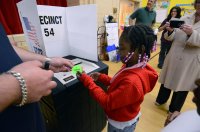Civics In the Elementary Classroom
There are plenty of opportunities for teaching young children how to take action on issues that are important to them.
Your content has been saved!
Go to My Saved Content.In December, Dane Best, a 9-year-old boy in a small Colorado town, convinced local legislators to overturn a century-old law banning snowball fights. He and his classmates wrote letters, and he presented his arguments at the town board meeting. Dane engaged in civic action, and he prevailed.
The importance of teaching civics in innovative and experiential ways is evident for middle and high school students. Teachers construct new, action-oriented ways to teach civics, and several states have enacted laws to beef up civics, or have made its study a graduation requirement. But participation in our democracy is ripe with possibility for younger children too.
There are a variety of ways that elementary teachers can bring civics concepts into the classroom.
Ask, “What Do I Believe?”
Provide students with an opportunity to identify issues they care about and help them research the topic and reflect on what they can do about it.
Discussing the concepts of fair and unfair engages young children quickly. Address current events that impact young people, or talk about a school or classroom rule that students want to change. Brainstorming about school or classroom rules is a way to encourage students to consider what they believe and why.
Lead students in a process to identify solutions by first defining the problem and then coming up with a list of possible ideas to resolve it. Test out those solutions (“Would this work? Can we do it?”) and choose one to try.
Make a Speech
After students identify issues that are important to them, they can deliver speeches about those issues. Speech writing and delivery can meet academic goals with practice in written and verbal expression and making arguments. At the same time, writing a speech helps students discover their passion and voice.
For example, Mikva Challenge’s Project Soapbox asks students to identify a topic and create a two-minute speech about it. The Kid President series offers another example of how young students might create speeches.
- Start with an opinion continuum, where you ask children to express their opinions about a current event topic. (“Should kids be allowed to sit where they want at lunch?”)
- Have students position themselves along the continuum (agree, disagree, not sure) and talk with each other.
- Ask students to write three sentences about why they are standing where they are. Younger students can share their answers aloud.
- Turn each of the three points into a few sentences that they practice with each other. These sentences become the foundation for their speech.
After writing and delivering their speeches, students can have discussions with each other about their positions and explore areas of agreement and disagreement. This sets the foundation for civil discourse, a central component of discussing controversial issues.
Bring Elections to Life
Use mock and real elections to teach students about the electoral process. Expand on a school’s student elections by using some key elements from real elections, such as:
- Holding a primary preceding the election and having students write and deliver speeches.
- Holding debates between candidates.
- Having students act as reporters and write articles about the candidates.
- Having candidates create campaign ads that other students assess.
These activities not only make the elections more rigorous and real, but also serve to diminish the risk of the election being a popularity contest.
Find Resources
There are many excellent children’s books that encourage civic engagement with the goal of improving society. Books like Grace for President highlight civic actions. Through the eyes of an elderly African American woman and her ancestors, we see the history of voting rights and the way that activism made a difference in Lillian’s Right to Vote. Dave Eggers’s book What Can a Citizen Do? gives simple actions children can take to engage in their communities.
Useful books do not need to focus exclusively on civic action; children can also learn from books centered around issues they care about. For example, Dreamers is a beautiful book that explains the value and opportunity of immigration in a way children can understand. Separate Is Never Equal traces the real-life story of a girl who wasn’t allowed to go to school because she was Mexican. As a result, her family was involved in a lawsuit that helped end school segregation in California.
Take Action
After students reflect on and explore issues they care about using some of these strategies, they may want to take action. Deciding on actions that are the right size for the particular age group is key. Project-based learning can engage the class in a project that takes action on an issue that’s important to them.
Children will carry civics lessons into adulthood—their impact can last a lifetime. The takeaways are not only about government and democracy but also how we treat one another, communicate, instill empathy, and fight for justice. If we impart those values when children are young, they can use them to improve their community, society, and world.
